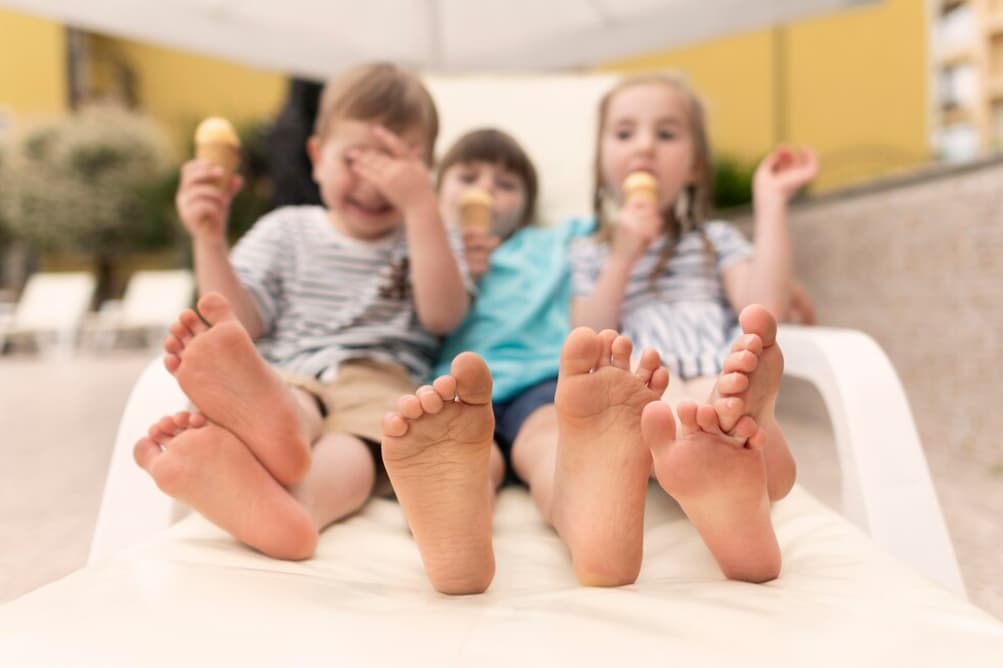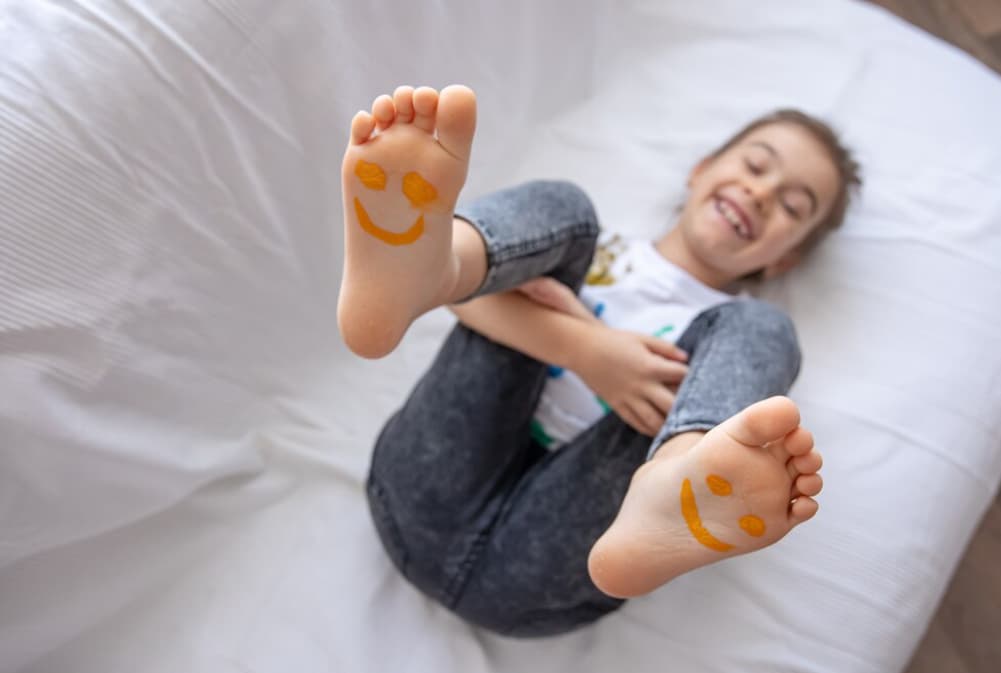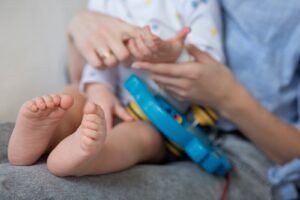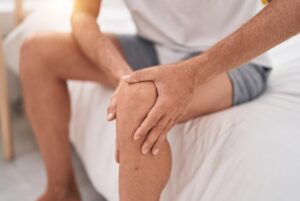Key Questions Addressed in this Article:
- What are growing pains in children, and what causes them?;
- How can one recognize the symptoms of growing pains in children?;
- What are the specific conditions related to growing pains, such as Sever’s Disease and Osgood-Schlatter Disease?;
- At what age are children most likely to experience growing pains, and can they extend into the teenage years?;
- What methods are used for diagnosing growing pains in children?;
- What are some effective at-home strategies for managing and alleviating growing pains?;
- How can professional podiatry support assist in the treatment of growing pains?;
- What preventative strategies can reduce the risk of growing pains in children?;
- What is the range of pediatric foot and leg conditions, and how can they be managed comprehensively?;
- Why is it important not to dismiss growing pains as a normal part of growth, and what steps can be taken for improvement?
Managing growth-related discomfort isn’t merely about alleviating immediate pain and inconvenience for young ones; it also involves ensuring they don’t have to sideline their cherished activities and time with friends.
Growth-related discomfort typically manifests in children aged 3 to 12 years, frequently coinciding with periods of rapid growth. Contrary to widespread belief, these pains are not an inevitable aspect of childhood that must be endured until they naturally subside. In reality, musculoskeletal pain always has an underlying cause, and pinpointing this cause allows for a clear and effective treatment strategy.
If you’re experiencing foot and knee pain, you may also like to explore effective remedies and preventive measures in our comprehensive article on foot and knee pain management.
Understanding Growing Pains: Origins and Mechanisms
Growing pains are a phenomenon tied to the development and enlargement of our bones and muscles. During the phase before bones reach full maturity, they contain areas known as ‘growth plates’—cartilaginous zones that serve as sites for new bone cell development, facilitating bone growth. These growth plates are less robust than the surrounding bone structure, rendering them more susceptible to discomfort under strain.
As the body grows, so do the muscles, undergoing periods of elongation and strengthening. This process sometimes involves periods of tightness as the muscles adjust to keep pace with the body’s overall growth. Muscles are connected to bones, and their movement exerts tension on these bones. When children engage in physical activity, this tension affects the growth plates, leading to irritation and discomfort. This reaction is the genesis of growing pains, which persist until the muscle and tendon-induced tension on the bone diminishes and stabilizes.
Identifying Symptoms of Growing Pains in Children
Episodes of growing pains can occur frequently, affecting around 43% of children who may experience attacks at least once a week, with some enduring daily discomfort for over six months. If your child is undergoing growing pains, watch out for these signs:
- Complaining of pain during or after physical activities, which usually eases with rest;
- Noticing that specific movements or positions of their feet and legs can either worsen or alleviate the symptoms;
- Waking up in the middle of the night due to pain;
- Exhibiting a limp after engaging in sports or physical activities;
- Displaying symptoms such as throbbing, redness, or swelling at the affected growth plate.
Sever’s Disease: Growing Pains in the Heels

Growing pains affecting the back of the heels are often attributed to Sever’s Disease. This condition arises when a tight Achilles tendon, connecting to the heel bone, tugs and inflames the growth plate located at the back of the heel. Given the significant force exerted by the Achilles tendon, especially during activities like running, this area is particularly prone to such discomfort. Despite its name, Sever’s Disease is not an illness but a treatable condition.
Osgood-Schlatter Disease: Growing Pains in the Knees
Growing pains manifesting in the knees may indicate Osgood-Schlatter Disease. This condition occurs when the tendon descending from the thighs and passing over the knee to attach at the top of the shin bone (tibia) irritates the nearby growth plate, leading to knee discomfort. Any actions involving knee bending, such as squatting or running, can trigger pain due to the stretching of this tendon. Medically termed Osgood-Schlatter disease, it is manageable with appropriate treatment.
Iselin’s Disease: Midfoot Growing Pains
Iselin’s Disease, characterized by growing pains in the midfoot region, targets the middle of the foot, particularly along the outer edge. This discomfort stems from irritation to the growth plate situated at the base of the fifth metatarsal, identifiable by a natural bony protrusion. The culprit behind this irritation is the peroneus brevis tendon.
Kohler Disease: A Concerning Foot Condition
Kohler Disease presents as pain, redness, and swelling centered around the navicular bone in the foot. Primarily affecting children aged between five and ten years, it results from a disruption in the foot’s blood supply, leading to potential bone damage, fracture, or collapse before eventual healing and solidification. While rare, if your child experiences discomfort in this area, prompt consultation with a podiatrist is essential.
Freiberg’s Infarction: Foot Bone Complications
Freiberg’s Infarction refers to the premature demise of bone tissue, commonly occurring at the head of the second metatarsal bone in the foot due to compromised blood supply. Typically afflicting children or teenagers in their early teens, symptoms may include foot ball pain, stiffness, swelling, and discomfort when bearing weight. If these symptoms arise, seeking professional podiatric care is crucial.
Growth Pain Age Range in Kids & Teens
Growing pains are most commonly experienced by children aged 3 to 12 years. However, individual variations in growth and development mean that some children and adolescents may encounter these pains at different stages, extending into their teenage years.
Diagnosis of Growing Pains in Children
The diagnosis of growing pains in children involves a holistic method that starts with a detailed conversation to understand the nature and patterns of their discomfort, including the onset of pain, factors that exacerbate it, and their daily physical activities. A thorough physical examination follows, aimed at identifying the source of the pain. This examination also includes a process to rule out other potential causes, such as muscle or tendon injuries. This comprehensive diagnostic approach helps in accurately determining the underlying issue, facilitating the recommendation of an effective treatment plan.
Managing and Alleviating Growing Pains: Strategies for Relief
Growing pains, while often resolving over time, can be a source of discomfort, potentially affecting a child’s participation in sports and physical activities. Strategies to manage these pains include implementing simple changes at home and consulting a podiatrist for a personalized treatment plan, aimed at ensuring children remain active and comfortable.
At Home Strategies:
- Applying ice packs to the affected area before and after physical activity for 10-15 minutes can mitigate discomfort;
- Ensuring children wear comfortable, supportive, and well-fitting shoes, and avoiding walking barefoot can provide necessary support and reduce pain;
- Daily stretching exercises tailored to the pain location can alleviate discomfort;
- Gentle muscle massage may also offer relief.
Professional Podiatry Support:
Podiatrists specialize in devising customized treatment plans to address and relieve growing pains, facilitating a child’s return to their preferred activities. Treatment strategies may include:
- Custom foot orthotics to correct alignment issues and support affected bones and tendons;
- Stretching and strengthening exercises to ease tendon strain and address muscle imbalances;
- Footwear assessments to identify and rectify any aggravating factors, recommending shoes that provide better support and alignment;
- Modifications to physical activities to encourage active recovery, including low-impact exercises that do not exacerbate the pain;
- Use of padding, strapping, and percussive therapy (e.g., Theragun) for immediate relief and support during activity, while waiting for more permanent solutions such as orthotics.
These approaches aim to reduce the impact of growing pains on daily life, ensuring children can continue engaging in sports and activities without significant discomfort.
Strategies for Mitigating the Risk of Growing Pains in Children
Reducing the likelihood of growing pains in children can be achieved through a series of proactive measures. Encouraging children to engage in thorough warm-up exercises before participating in sports activities can significantly help in loosening their muscles, thereby minimizing the risk of discomfort. Monitoring and aiding in the maintenance of proper sports techniques is also crucial in preventing unnecessary stress on their developing bodies. It may be beneficial to limit participation in sports that specifically exacerbate pain in sensitive areas, thus avoiding the triggering of painful symptoms. Furthermore, ensuring that children wear supportive and well-fitted shoes designed with adequate shock absorption can provide essential support to their growing bodies, thereby contributing to the prevention of growing pains.
Comprehensive Care for Pediatric Foot and Leg Conditions

A broad spectrum of foot and leg issues in children is addressed and managed, covering conditions from common to complex. These include:
- In-toeing and out-toeing adjustments;
- Correction for knock knees and bow legs;
- Management of shin splints;
- Solutions for toe walking;
- Treatment for ankle sprains;
- Remedies for hammertoes;
- Removal of plantar warts;
- Care for ingrown toenails;
- Approaches to manage pain associated with hypermobility;
- Alleviation of tired, achy legs.
Identifying foot and leg problems in children can be challenging, particularly if they do not express discomfort. It’s advisable to seek a professional foot evaluation for children exhibiting signs such as:
- Unusual walking patterns;
- Frequent tripping and falling;
- Difficulty keeping pace with peers during physical activities;
- Skin rashes between toes;
- Discoloration or pain associated with toenails, potentially indicating ingrown toenails;
- Shoes showing uneven wear patterns;
- Limping or favoring one leg;
- Noticeable foot or leg misalignments;
- Presence of hard skin lumps or bumps.
Conclusion
Growing pains, while common, should never be dismissed as a normal part of growth. Understanding the cause of these pains is the first step to providing relief to children. By seeking professional advice and implementing healthy habits, a child’s experience of growing pains can be significantly improved.
Growing pains in children, while common, should never be dismissed as mere side effects of childhood growth. There are in-depth explanations and effective solutions for these pains. In understanding the cause of these aches, parents and caregivers can better assist in providing relief to children. With the right blend of professional help and implementing healthy habits at home, a child’s experience of growing pains can be significantly alleviated. It’s important that children continue to engage in the activities they love, without the hindrance of growing pains.
FAQs
Active children may exert more stress on their developing bones, which can lead to growing pains. However, a lack of physical activity does not prevent growing pains from occurring.
The duration of growing pains varies; they can last from a few weeks to months, or in some cases, years.
Differentiating between growing pains and injuries can be complex since traumatic injuries are usually associated with a distinct event, while overuse injuries and growing pains develop gradually. A definitive diagnosis typically requires evaluation by a specialist, such as a podiatrist.
Children as young as 2 years old can be evaluated by a podiatrist for foot and leg health concerns.
Flat feet can elevate the risk of foot and leg pain and related issues, including growing pains. However, if a child with flat feet is not experiencing pain or other problems, treatment may not be necessary at a young age.


